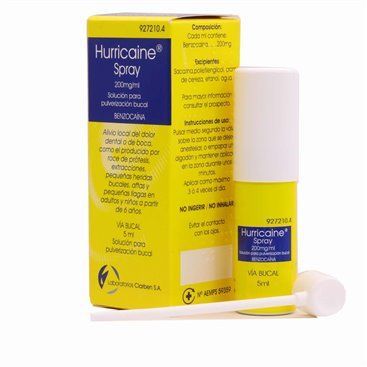Hurricaine Spray 200 Mg/Ml Oral Spray Solution 5 Ml
It is indicated for the local relief of dental or mouth pain, such as that produced by rubbing prostheses, extractions, small mouth wounds, canker sores and small sores in adults and children from 6 years of age.
It is indicated for the local relief of dental or mouth pain, such as that produced by rubbing prostheses, extractions, small mouth wounds, canker sores and small sores in adults and children from 6 years of age.
Hurricaine Spray (200 Mg / Ml Solution For Oral Spray 1 Bottle 5 Ml)
Benzocaine
ACTION AND MECHANISM
It works by blocking the sensory receptors of the mucous membranes, locally. It does not penetrate inside, so it is ineffective in inflammatory or dental pain originating in deep areas of the teeth and gums.
Benzocaine has a really low pK of 3.5, which makes it provide adequate superficial anesthesia. The latency or onset of action period is 30-60 seconds, with the duration of the effect being 10-15 minutes.
PHARMACOKINETICS
Benzocaine is absorbed in a very small amount through the mucous membranes. It is hydrolyzed to PABA-containing metabolites by plasma cholinesterases and, to a much lesser extent, by liver cholinesterases. Excretion is mainly through the kidneys, mainly as metabolites.
INDICATIONS
- Symptomatic relief of [DENTALGIA] and pain in the oral mucosa.
POSOLOGY
"HURRICAINE SPRAY"
- Adults: 1 application in the area to be treated, a maximum of 3 or 4 times a day.
- Children and adolescents <18 years:
* Adolescents from 12 years old: the same as adults.
* Children 6-12 years: only under the supervision of an adult. Apply as in the previous case.
* Children 2-6 years: under medical supervision.
* Children under 2 years: not recommended.
Duration of treatment : it should be as short as possible. If after 2 days of treatment the patient worsens or symptoms persist, the clinical situation should be evaluated.
RULES FOR CORRECT ADMINISTRATION
- Hurricaine spray: uncover the bottle and apply on the area to be anesthetized, pressing the valve for half a second or soaking a cotton ball with several pulsations and keep it applied to the area for several minutes. Wash your hands after each application.
The anesthesia caused by this medicine at the level of the throat can promote coughing during the meal, giving the impression of choking. This medicine should not be used before eating or drinking.
CONTRAINDICATIONS
- Hypersensitivity to benzocaine, [ALLERGY TO LOCAL ANESTHETICS TYPE ESTER] or to other derivatives of p-aminobenzoic acid (PABA).
- Children under 2 years of age. Nani-Predental should not be used in children younger than 4 months.
PRECAUTIONS
- [METAHEMOGLOBINEMIA]: Described cases of methemoglobinemia in patients (mostly children under 4 years of age) to whom benzocaine gel or liquid was administered to relieve tooth pain. In most cases the product had been used incorrectly or excessively, although there were also some with proper use. Children under four years of age, elderly patients, and patients with certain congenital malformations such as glucose-6-phosphodiesterase deficiency, hemoglobin-M disease, NADH-methemoglobin reductase (diaphorase 1) deficiency, and pyruvate kinase deficiency may also have increased risk of developing methemoglobinemia.
ADVICE TO THE PATIENT
- Do not use for more than 7 consecutive days.
- Do not apply this medicine more than 4 times a day, always using the smallest dose that relieves pain.
- Do not chew food or gum while numbness persists due to the risk of biting the tongue or oral mucosa.
- The buccal application of benzocaine can cause problems in swallowing and therefore risk of aspiration. So it is recommended not to eat in the hour after its application and avoid spraying in the throat.
- Contains benzocaine so watch out for signs or symptoms of methemoglobinemia such as pale, gray or bluish discoloration of the skin, lips and nails, shortness of breath, fatigue, confusion, headache, dizziness and rapid heart rate.
SPECIAL WARNINGS
- Warn patients of the risk of methemoglobinemia. Symptoms can appear within minutes to an hour or two after using benzocaine. Symptoms can occur with the first or subsequent applications of benzocaine.
INTERACTIONS
- Sulfamides: PABA, a product of benzocaine metabolism, can inhibit the action of sulfonamides. Avoid joint administration
ADVERSE REACTIONS
- With prolonged use of benzocaine, [HYPERSENSITIVITY REACTIONS] (<1%) consisting of [CONTACT DERMATITIS] may occur. Other hypersensitivity reactions such as [EXANTEMATIC ERUPTIONS], [URTICARIA], [EDEMA] or [ANAPHYLAXIA] are extremely rare.
- Prolonged contact of benzocaine with the mucous membranes can cause dehydration of the epithelium and hardening of the mucous membranes. A burning sensation in the mouth has been described.
- Due to prolonged use, the following have been reported: [DYSGEUSIA], bad taste in the mouth, dehydration of the mucous membranes and swallowing difficulties.
- Exceptionally, benzocaine has been associated with the production of [METAHEMOGLOBINEMIA], characterized by [CYANOSIS]. Most cases of methemoglobinemia in children occur from overdose, accidental ingestion, and misuse of benzocaine preparations.
Leaflet Hurricaine Spray 200 Mg / Ml Solution For Oral Spray 5 Ml



